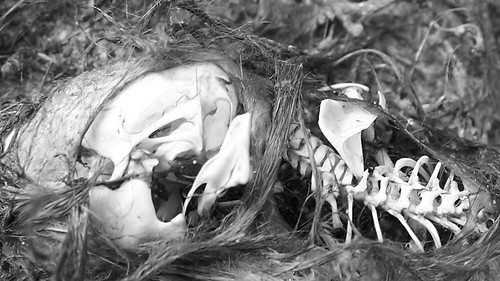memento mori, originally uploaded by tempophage.
"My wife was disgusted. My daughter was fascinated."
"My wife was disgusted. My daughter was fascinated."
❂
From The Art Bulletin, The March, 2005: Behind the sensationalism: Images of a decaying corpse in Japanese Buddhist art by Fusae Kanda
The relation of the order of the nine stages in the Nakamura version to textual sources has been interpreted variously. The order of the stages of decay in the handscroll is as follows: (0) predeath portrait; (1) newly deceased; (2) distension; (3) rupture; (4) exudation of blood; (5) putrefaction; (6) discoloration and desiccation; (7) consumption by birds and animals; (8) skeleton; and (9) disjointing.
The closest match of the order of decay in the Nakamura version is to the description of the Discourse on Mahayana Meditation and Contemplation, but with a few differences. An image of the newly deceased was inserted as the first stage of the Nakamura version, and to limit the total number to nine, the ninth stage of bones being parched to dust was omitted.
Another, more significant, difference is found in the eighth stage. According to the text, in the stage of dismemberment, "the head and hands are located in different places, and five organs are detached from the body and shrunken." The Nakamura version does not show the stage of dismemberment. Instead, it displays two different forms of bones in the eighth and ninth stages: a whole skeleton and a disjointing of the bones. Thus, the key to interpreting the divergent order of decay in the Nakamura version lies in the reason for articulating two forms of the skeleton and omitting the stage of dismemberment.
As we have noted, descriptions of the nine stages of a decaying corpse are found in many Buddhist sources. The texts vary in their ordering and description of the decomposition process, but three share an identical sequence: the Discourse on Mahayana Meditation and Contemplation, the Discourse on the Great Wisdom, and the Explanations of the Doctrines on Meditation for Enlightenment (Japanese: Shakuzen haramitsu shidai homon, Chinese: Shichan bolomi cidi famen, by Zhiyi, 568-75). The lack of consistency among the surviving documents may indicate that the order itself was not critical. While the subtitles given to each of the nine stages vary among the sources, the designations share similar meanings for each of the relevant stages, with one obvious exception.
Some sources specify one stage relating to bones, and others include two such stages: a whole skeleton and disjointed bones. For sources mentioning a single stage of bones, the texts refer to either a whole skeleton or disjointed bones. For sources that give contemplations on two stages of bones, the whole skeleton and the disjointed bones are designated as distinct objects for meditation in two sequential stages. In these sources, the stage of dismemberment is omitted to allow for the inclusion of two contemplations on different forms of bones.
What could have motivated the distinct contemplations on a whole skeleton and the separated bones?

No comments:
Post a Comment